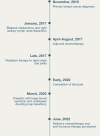Presentation of metastatic breast cancer as a large bowel obstruction in an elderly female with resultant diverting ileostomy: case report
- PMID: 38751512
- PMCID: PMC11092987
- DOI: 10.21037/tbcr-22-27
Presentation of metastatic breast cancer as a large bowel obstruction in an elderly female with resultant diverting ileostomy: case report
Abstract
Background: Breast cancer metastases generally occur in the lymph nodes, bone, lungs, or liver. Very rarely does a primary breast cancer metastasize to the colon, and even more rarely does the metastasis cause a large bowel obstruction. To our knowledge, there are no reports in the literature of the surgical management of elderly patients presenting with metastatic breast cancer as a large bowel obstruction. Here we present an unusual case of breast cancer metastasis of an elderly female, years after initial diagnosis and treatment of the primary breast cancer, that metastasized to the ascending colon and presented as a large bowel obstruction, ultimately treated with diverting ileostomy. The patient's rare presentation illustrates the necessity to consider metastatic breast cancer among patients with large bowel obstruction, and the consideration for palliation of symptoms with diversion.
Case description: The patient is an 84-year-old otherwise healthy female with history of right breast invasive lobular carcinoma, who underwent bilateral mastectomy, right axillary lymph node dissection, and adjuvant chemotherapy, radiation, and letrozole in 2017. In March of 2022, the patient presented with radiographic evidence of a proximal large bowel obstruction. On exploratory laparotomy she was found to have an ascending colon mass as well as widespread intra-abdominal carcinomatosis consistent with metastatic breast cancer. She underwent a diverting loop ileostomy for palliation of her obstructive symptoms and later followed with oncology for palliative chemotherapy and anti-hormone therapy. She overall recovered well without any future plans for surgical intervention.
Conclusions: Although uncommon, it is important to consider metastatic disease when evaluating patients with history of breast cancer for large bowel obstruction. Failure to do so can result in a delay in recognition of metastatic tumor biology or even a misdiagnosis. This may impede appropriate treatment and may contribute to significant morbidity or even mortality for patients.
Keywords: Lobular; case report; colon; metastasis.
2022 Translational Breast Cancer Research. All rights reserved.
Conflict of interest statement
Conflicts of Interest: All authors have completed the ICMJE uniform disclosure form (available at https://tbcr.amegroups.com/article/view/10.21037/tbcr-22-27/coif). The authors have no conflicts of interest to declare.
Figures






References
Publication types
LinkOut - more resources
Full Text Sources
